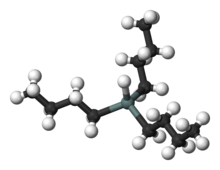Chemistry:Tributyltin hydride
| |||

| |||
| Names | |||
|---|---|---|---|
| Systematic IUPAC name
Tributylstannane[1] | |||
| Identifiers | |||
3D model (JSmol)
|
|||
| 3587329 | |||
| ChEBI | |||
| ChemSpider | |||
| EC Number |
| ||
| 4258 | |||
| MeSH | Tributyltin | ||
PubChem CID
|
|||
| UNII | |||
| |||
| |||
| Properties | |||
| SnC12H28 | |||
| Molar mass | 291.06 g mol−1 | ||
| Density | 1.082 g cm−3 | ||
| Boiling point | 80 °C (176 °F; 353 K) at 50 Pa | ||
| Slowly reacts[citation needed] | |||
Except where otherwise noted, data are given for materials in their standard state (at 25 °C [77 °F], 100 kPa). | |||
| Infobox references | |||
Tributyltin hydride is an organotin compound with the formula (C4H9)3SnH. It is a colorless liquid that is soluble in organic solvents. The compound is used as a source of hydrogen atoms in organic synthesis.
Synthesis and characterization
The compound is produced by reduction of tributyltin oxide with polymethylhydrosiloxane:[2][3]
- 2 "[MeSi(H)O]n" + (Bu3Sn)2O → "[MeSi(OH)O]n" + 2 Bu3SnH
The hydride is a distillable liquid that is mildly sensitive to air, decomposing to (Bu3Sn)2O. Its IR spectrum exhibits a strong band at 1814 cm−1 for νSn−H.
Applications
It is a specialized reagent in organic synthesis. Combined with azobisisobutyronitrile (AIBN) or by irradiation with light, tributyltin hydride converts organic halides (and related groups) to the corresponding hydrocarbon. This process occurs via a radical chain mechanism involving the radical Bu3Sn•.[4][5] The radical abstracts a H• from another equivalent of tributyltin hydride, propagating the chain. Tributyltin hydride's utility as a H• donor can be attributed to its relatively weak bond strength (78 kcal/mol).[6]
It is the reagent of choice for hydrostannylation reactions:[7]
- RC2R′ + HSnBu3 → RC(H)=C(SnBu3)R′
See also
References
- ↑ "SnBu3H - PubChem Public Chemical Database". The PubChem Project. USA: National Center for Biotechnology Information. https://pubchem.ncbi.nlm.nih.gov/summary/summary.cgi?cid=5948.
- ↑ Maleczka, Robert E.; Terrell, Lamont R.; Clark, Damon H.; Whitehead, Susan L.; Gallagher, William P.; Terstiege, Ina (1999). "Application of Fluoride-Catalyzed Silane Reductions of Tin Halides to the in Situ Preparation of Vinylstannanes". J. Org. Chem. 64 (16): 5958–5965. doi:10.1021/jo990491+.
- ↑ Tormo, J.; Fu, G. C. (2002). "α-D-Ribo-hexofuranose, 3-deoxy-1,2:5,6-bis-O-(1-methylethylidene)". Org. Synth. 78: 239. doi:10.15227/orgsyn.078.0239.
- ↑ OUP catalogue page, J. Clayden, N. Greeves, S. Warren and P. Wothers, in Organic Chemistry, 2000, OUP, Oxford, ch. 39, pp. 1040-1041.
- ↑ T. V. (Babu) RajanBabu, Philip C. Bulman Page, Benjamin R. Buckley, "Tri-n-butylstannane" Encyclopedia of Reagents for Organic Synthesis 2004, John Wiley & Sons. doi:10.1002/047084289X.rt181.pub2
- ↑ Laarhoven, L. J. J.; Mulder, P.; Wayner, D.D. M. "Determination of Bond Dissociation Enthalpies in Solution by Photoacoustic Calorimetry" Acc. Chem. Res. 1999, 32, 342 doi:10.1021/ar9703443
- ↑ Smith, Nicholas D.; Mancuso, John; Lautens, Mark (2000). "Metal-Catalyzed Hydrostannations". Chemical Reviews 100 (8): 3257–3282. doi:10.1021/cr9902695. PMID 11749320.
Further reading
- Hayashi, K.; Iyoda, J.; Shiihara, I. "Reaction of organotin oxides, alkoxides and acyloxides with organosilicon hydrides. New preparative method of organotin hydrides " J. Organomet. Chem. 1967, 10, 81. doi:10.1016/S0022-328X(00)81719-2
 |



